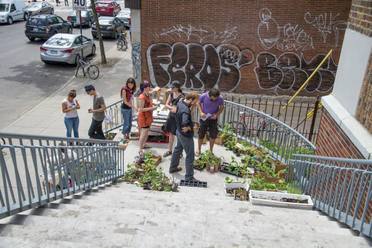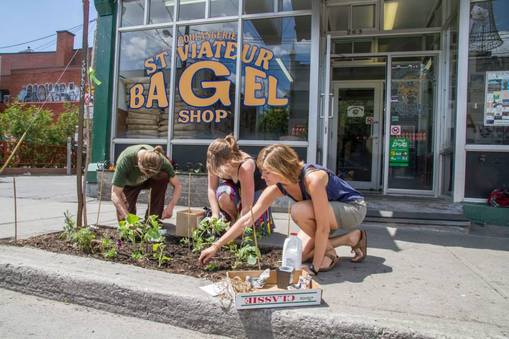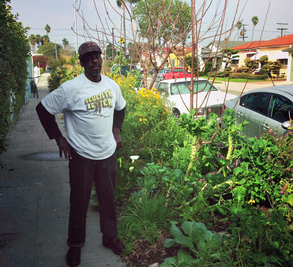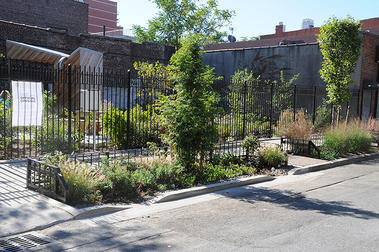By Anna Zisa
Beautiful initiatives are growing around the world, one is about growing food in urban spaces. Tomatoes, kale, basil, corn, beans, squash, fruit and nut trees and wild flowers for the bees and much more, growing on sidewalks, balconies, rooftops, edges of parks and parking lots, back alleys, and empty lots: is what many urban gardeners envision and are sprouting into reality. Certainly, living in cities has made us, urban dwellers, forget things such as what a tomato plant looks like, that strawberries don’t grow in February, that bees and other insects also need to eat, or that the soil is not simply dirt but a magical substance that if healthy, can be full of life and potential.
Well, the idea of growing food near where urban consumers are is not new. In fact the contrary -producing food far away from consumers-, doesn’t make much logical sense. But the industrialization of the food system along with efficient long distance transportation has allowed cities to import most of their food and decreased their reliance on local farms. A century ago, when the phenomenon of distancing the urban consumer population with the production of food was in its early stages, visionary Ebenezer Howard, published his book Gardens of To-morrow conceptualizing human settlements in a combination of town and country. Unfortunately, most cities that were born in North America since then were not planned with this concept, but instead with single functional zoning and bylaws that prohibit farming where most people live. However today, some of these cities and suburbs are currently being retrofitted often by grassroots initiatives. These initiatives are looking to bring life and derive beneficial products from confined unused spaces within a concrete and asphalt environment.
 photo credit: Geoffrey Boulangé
photo credit: Geoffrey Boulangé Last weekend in Montreal, a group of proactive people organized a planting day around a neighbourhood, the Mile End. They had planted from seed a bunch of vegetable plants and flowers in their apartment hallways and bedrooms. Neighbors, citizens, and people walking by showed up and were distributed an association of plants to be planted around the area transforming the neighborhood into an edible one while the summer lasts. The associations of plants were such that they work well together: some provide nutrients to the other, attract pollinators or beneficial insects that predate pests, offer soil cover to prevent weeds, or create just the right amount of shade. These beneficial associations of plants, also called guilds, are common in Permaculture Design. The transformation of the now edible Mile End seemed to flow well and simply because it was a collective effort. On a side note, some of the reoccurring concerns when it comes to use public spaces for growing food are "Who will take care of the plants?" and "People are going to steal them!", but the idea is about attempting to create a community that shares and respects sources of life and subsistence. Not acting and hoping for the best because of fear is outdated in these times of pressing need for change.
 photo credit: Geoffrey Boulangé
photo credit: Geoffrey Boulangé "You'd be surprised what the soil could do if you let it be your canvas. You just couldn't imagine how amazing a sunflower is and how it affects people."
–Ron Finley

Another great example is Ron Finley, an artist and “guerrilla gardener” from South Central LA. He is converting the strip between the sidewalks and the streets typically covered with lawn with diverse edible plants from which he hopes to unleash a healthier food culture and reclaim access to healthy and safe food in a place where fast foods reign. He has an inspirational and amusing TEDtalk about it.
“Gardening is the most therapeutic and defiant act you can do, especially in the inner city. Plus you get strawberries.”
–Ron Finley
“Gardening is the most therapeutic and defiant act you can do, especially in the inner city. Plus you get strawberries.”
–Ron Finley

Getting people to think about alternative food systems, realizing the thriving potential unused/wasted spaces have, using food as a vehicle for community building or hoping to improve city dwellers’ physical health through a better nutrition -as Ron Finley says amusingly “if kids grow kale, they eat kale”-, are just a few of the numerous positive consequences of gardening urban spaces. Vegetation helps mitigating the urban heat island effect, cleans the air, can help absorb excess water in time of storms not to mention the psychological advantages greenery has in humans.
In NYC, vegetation’s function of absorbing water has inspired the design of bioswales, curbside gardens with a deep layered system and plants purposely chosen because they take a lot of water. These bioswales can help absorb runoff in times of storm when the pipes can’t handle the excess water and sewage can overflow into local waterways. This bioswales thus help saving the city highly pricey infrastructure such as new pipe systems. Plus some of the plants on these bioswales can be edible thereby being multifunctional!
In a farmer's market in Cincinnati last summer, I bought vegetables from kids that are some of the youth that plans, plants, grows, harvests, markets, eats and prepares organic food as a part of the Permaganic Eco Garden program. Permaganic is a wonderful program that has converted a plot in the middle of Cincinnati into a permaculture and organic vegetable garden that invites the youth to learn life-skills such as growing food, managing market sales and cooking. This is just another creative and beautiful initiative sparking in people who wouldn’t necessarily be into farming, the interest on the way food grows, the relationship between the air, soil, water and energy, the connection between diet and health and ultimately realize how dependent we are to the land (click here for a video of the Eco Garden with interviews of the happy youth working there).
Check out the movie Edible City: Grow the Revolution for free on youtube just to get a glance on how urban agriculture is restoring our food system through the involvement of marginalized communities.
There are tons of these initiatives out there today all around the globe, and it is beautiful to see Permaculture Design helping turning the wheels of these ideas, from their conceptualization to their realization. A shift is occurring, one that brings alternative means of producing food characteristically local and this is all very exciting!
Looking forward for the urban permaculture section of the Permaculture Design Course in Portugal and Ibiza this September.
In NYC, vegetation’s function of absorbing water has inspired the design of bioswales, curbside gardens with a deep layered system and plants purposely chosen because they take a lot of water. These bioswales can help absorb runoff in times of storm when the pipes can’t handle the excess water and sewage can overflow into local waterways. This bioswales thus help saving the city highly pricey infrastructure such as new pipe systems. Plus some of the plants on these bioswales can be edible thereby being multifunctional!
In a farmer's market in Cincinnati last summer, I bought vegetables from kids that are some of the youth that plans, plants, grows, harvests, markets, eats and prepares organic food as a part of the Permaganic Eco Garden program. Permaganic is a wonderful program that has converted a plot in the middle of Cincinnati into a permaculture and organic vegetable garden that invites the youth to learn life-skills such as growing food, managing market sales and cooking. This is just another creative and beautiful initiative sparking in people who wouldn’t necessarily be into farming, the interest on the way food grows, the relationship between the air, soil, water and energy, the connection between diet and health and ultimately realize how dependent we are to the land (click here for a video of the Eco Garden with interviews of the happy youth working there).
Check out the movie Edible City: Grow the Revolution for free on youtube just to get a glance on how urban agriculture is restoring our food system through the involvement of marginalized communities.
There are tons of these initiatives out there today all around the globe, and it is beautiful to see Permaculture Design helping turning the wheels of these ideas, from their conceptualization to their realization. A shift is occurring, one that brings alternative means of producing food characteristically local and this is all very exciting!
Looking forward for the urban permaculture section of the Permaculture Design Course in Portugal and Ibiza this September.

 RSS Feed
RSS Feed
